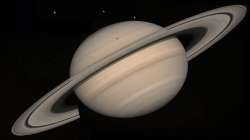20 new moons discovered at Saturn, beats Jupiter on moon count
The more-distant retrograde moons and one of the prograde moons each take more than three years to complete an orbit.

Saturn now has 82 moons - three more than Jupiter's 79 moons - and each of the 20 newly-discovered Saturn moons is about five kms in diameter. A team led by Scott S. Sheppard from Carnegie Institute of Science found 20 new moons orbiting Saturn. Seventeen of them orbit the planet backwards, or in a retrograde direction, meaning their movement is opposite of the planet's rotation around its axis.
The other three moons orbit in the prograde -- the same direction as Saturn rotates.
Two of the prograde moons are closer to the planet and take about two years to travel once around Saturn.
The more-distant retrograde moons and one of the prograde moons each take more than three years to complete an orbit.
"Studying the orbits of these moons can reveal their origins, as well as information about the conditions surrounding Saturn at the time of its formation," said Sheppard.
The new moons were discovered using the Subaru telescope atop Mauna Kea in Hawaii. The observing team included Sheppard, David Jewitt of University of California Los Angeles and Jan Kleyna of the University of Hawaii.
These moons may have once comprised a larger moon that was broken apart in the distant past.
"The fact that these newly discovered moons were able to continue orbiting Saturn after their parent moons broke apart indicates that these collisions occurred after the planet-formation process was mostly complete and the disks were no longer a factor," Sheppard noted.
The "retrograde" moons have similar inclinations to other previously known retrograde Saturnian moons, indicating that they are also likely fragments from a once-larger parent moon that was broken apart.
"This kind of grouping of outer moons is also seen around Jupiter, indicating violent collisions occurred between moons in the Saturnian system or with outside objects such as passing asteroids or comets," explained Sheppard.
Last year, Sheppard discovered 12 new moons orbiting Jupiter and Carnegie hosted an online contest to name five of them.
"This time, the moons must be named after giants from Norse, Gallic, or Inuit mythology," said Sheppard.
Also Read | NASA sets first all-female spacewalk after suit flap in spring
Also Read | Chandrayaan 2’s Orbiter payload detects charged particles on Moon